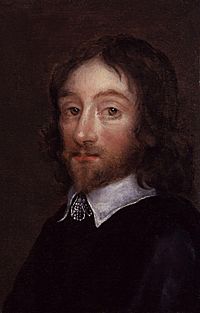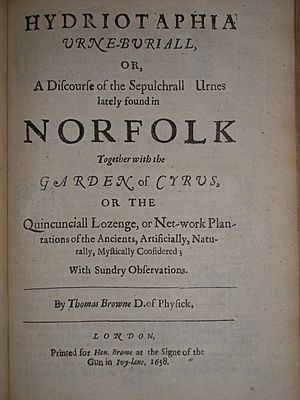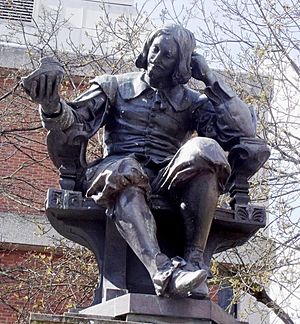Thomas Browne facts for kids
Quick facts for kids
Thomas Browne
|
|
|---|---|

|
|
| Born | 19 October 1605 London, England
|
| Died | 19 October 1682 (aged 77) Norwich, England
|
| Alma mater | Winchester College, Pembroke College, Oxford, University of Padua, University of Leiden |
| Known for | Religio Medici, Urne-Burial and The Garden of Cyrus, Pseudodoxia Epidemica, Christian Morals |
Sir Thomas Browne (born October 19, 1605 – died October 19, 1682) was an English writer and thinker. He was a polymath, meaning he knew a lot about many different subjects. These included science, medicine, religion, and even mysterious topics.
Browne loved to explore the natural world. His ideas were shaped by the scientific revolution, which encouraged looking for facts. His writings also often mentioned ancient Greek and Roman texts and the Bible. He had a unique way of writing, sometimes funny and sometimes very serious. His style changed depending on what he was writing about. This made his writing rich and special.
Contents
About Thomas Browne
His Early Life and Education
Thomas Browne was born in London, England, on October 19, 1605. He was the youngest of four children. His father was a silk merchant, but he died when Thomas was young. His mother later remarried.
Browne went to Winchester College for school. In 1623, he started studying at Oxford University. He finished his degree in 1627. After that, he studied medicine in Europe, at universities in Padua, Montpellier, and Leiden. He earned his medical degree in 1633.
In 1637, Browne moved to Norwich, England. He worked as a doctor there until he died. In 1641, he married Dorothy Mileham. They had ten children together.
His Important Books

Browne's first famous book was Religio Medici, which means The Religion of a Physician. He first shared it with friends as a handwritten copy. In 1642, someone published it without his permission. This version included some unusual religious ideas. He then released an official version in 1643, with some changes.
In 1646, Browne published a large book called Pseudodoxia Epidemica. Its full title means Enquiries into Very many Received Tenents, and commonly Presumed Truths. This book looked into many false beliefs and common mistakes people had at the time. Browne used a scientific approach to show why these ideas were wrong. This book was important for the history of science. It helped people learn about new scientific discoveries.
Later, in 1658, Browne published two more important writings. One was Hydriotaphia, Urn Burial. He wrote it after ancient pots were found in Norfolk. This book was a deep reflection on death and how different cultures buried their dead. The other writing was The Garden of Cyrus. This book explored patterns in nature and art, especially a crisscross pattern called a quincunx.
Later Years and Knighthood
Like most people in the 1600s, Browne believed in angels and witchcraft. He was present at a witch trial in 1662. His thoughts on a similar trial in Denmark might have influenced the jury.
In 1671, King Charles II visited Norwich. The King and his court also visited Browne's home. A royal banquet was held in the city. The Mayor of Norwich was offered a knighthood, but he suggested that Sir Thomas Browne receive the honor instead. So, Browne was knighted by the King.
His Death and Legacy

Sir Thomas Browne died on October 19, 1682, which was his 77th birthday. He was buried in a church in Norwich. His collection of books was later sold. Many of these books became part of the founding collection of the British Library.
His Own Words
In 1673, Thomas Browne wrote a short story about his life for a friend, John Aubrey. Here is what he wrote:
- ...I was born in St Michael's Cheap in London, went to school at Winchester College, then went to Oxford, spent some years in foreign parts, was admitted to be a Socius Honorarius of the College of Physicians in London, Knighted September 1671, when the King Charles II, the Queen and Court came to Norwich. Writ Religio Medici in English, which was since translated into Latin, French, Italian, High and Low Dutch, Pseudodoxia Epidemica, or Enquiries into Common and Vulgar Errors translated into Dutch four or five years ago. Hydriotaphia, or Urn Buriall. Hortus Cyri, or de Quincunce. Have some miscellaneous tracts which may be published...(Letters 376)
How He Influenced Others
Many people think Sir Thomas Browne was one of the most original writers in English. His ideas were fresh and clever. His writing style was often grand and used many Latin words. He was a devoted Christian, a supporter of new science, and also interested in old, mysterious knowledge.
Browne is listed as one of the top writers in the Oxford English Dictionary. He created many new words, especially in science and medicine. Some words he coined include 'ambidextrous', 'analogous', 'carnivorous', 'coexistence', 'computer', 'electricity', 'hallucination', 'literary', 'locomotion', 'medical', and 'veterinarian'.
His writing style has influenced authors for hundreds of years:
- In the 1700s, Samuel Johnson praised Browne's writing. He said Browne used many different words to express his unique ideas.
- In the 1800s, writers like Thomas De Quincey, Samuel Taylor Coleridge, and Charles Lamb admired Browne.
- The American writer Herman Melville was greatly influenced by Browne's style.
- Edgar Allan Poe used a quote from Browne's Hydriotaphia in his famous story "The Murders in the Rue Morgue".
In the 1900s and beyond, many people continued to admire Browne:
- The American scientist Stephen Jay Gould was a fan.
- The novelist Joseph Conrad used a quote from Browne in his 1913 novel Chance.
- The English author Virginia Woolf wrote about him. She said, "Few people love the writings of Sir Thomas Browne, but those that do are the salt of the earth."
- The composer William Alwyn wrote a symphony in 1973 inspired by Browne's book Hydriotaphia, Urn Burial.
- The Canadian doctor William Osler, who helped create modern medicine, was a big admirer of Browne.
- The Argentinian writer Jorge Luis Borges often mentioned Browne in his works. He called Browne "the best prose writer in the English language."
- In his short story "The Celestial Omnibus", E. M. Forster makes Browne a character who helps a young boy understand the beauty of literature.
- The Spanish writer Javier Marías translated two of Browne's books into Spanish.
- The playwright Tony Kushner wrote a play called Hydriotaphia, or the Death of Doctor Browne, imagining Browne's last days.
Portraits and Art Influence
- The National Portrait Gallery in London has a painting of Sir Thomas Browne and his wife, Dorothy. It was likely painted between 1641 and 1650.
- There is a statue of Sir Thomas Browne in Norwich city center. It was put there in 1905.
- In 1931, the English painter Paul Nash created 32 illustrations for Browne's books Urn Burial and The Garden of Cyrus.
- In 2005, a small statue of Browne was made to celebrate his 400th birthday.
Images for kids
See also
 In Spanish: Thomas Browne para niños
In Spanish: Thomas Browne para niños
- Francis Bacon
- Johannes Kepler
- Scientific Revolution
- Neoplatonism
- Hermeticism
- The Garden of Cyrus
- Hydriotaphia, Urn Burial
- Library of Sir Thomas Browne







